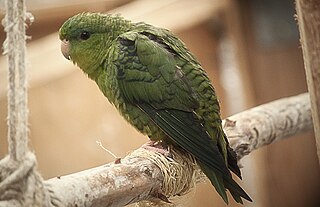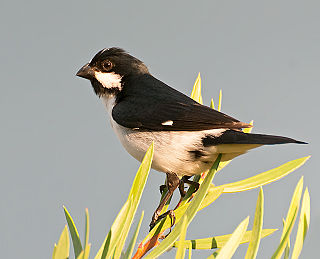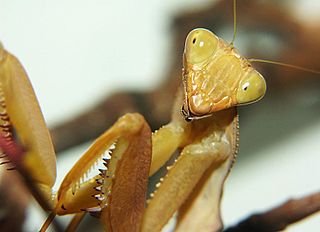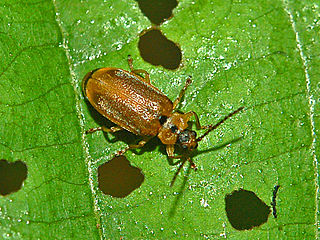| Rutela lineola | |
|---|---|
 | |
| Rutela lineola from Argentina | |
| Scientific classification | |
| Kingdom: | |
| Phylum: | |
| Class: | |
| Order: | |
| Family: | |
| Genus: | |
| Species: | R. lineola |
| Binomial name | |
| Rutela lineola | |
Rutela lineola is a species of beetles from the family Scarabaeidae.
| Rutela lineola | |
|---|---|
 | |
| Rutela lineola from Argentina | |
| Scientific classification | |
| Kingdom: | |
| Phylum: | |
| Class: | |
| Order: | |
| Family: | |
| Genus: | |
| Species: | R. lineola |
| Binomial name | |
| Rutela lineola | |
Rutela lineola is a species of beetles from the family Scarabaeidae.
Rutela lineola can reach a length of about 16–20 mm. This species is very variable. The basic colour is black, with white, yellow, orange or reddish markings on the head, the pronotum and the elytra. Adults feed on flowers and on decaying wood. Larvae are xylophagous and they are usually found inside decaying trunks.
This species can be found in Argentina, Paraguay, Uruguay, Brazil, Colombia and Peru.

Alopecurus pratensis, known as the meadow foxtail or the field meadow foxtail, is a perennial grass belonging to the grass family (Poaceae). It is native to Europe and Asia.

Thymelicus lineola, known in Europe as the Essex skipper and in North America as the European skipper, is a species of butterfly in the family Hesperiidae.

Brachypodium pinnatum, the heath false brome or tor-grass, is a species of grass with a widespread distribution in temperate regions of the Northern Hemisphere. It typically grows in calcareous grassland, and reaches 70–120 centimetres (28–47 in) tall. The flowerhead is open, with 10 to 15 erect spikelets.

The barred parakeet, also known as the lineolated parakeet or the Catherine parakeet, is a small parrot found disjunctly in highland forests from southern Mexico to Panama, in the Andes from western Venezuela to southern Peru and Bolivia, the Santa Marta Mountains in Colombia and the Venezuelan Coastal Range. Its plumage is mostly green with multiple black and dark green stripes or bars, and it has a pale-horn coloured beak. The dark stripes vary in prominence between its two subspecies. Several colour mutants are available in aviculture.

Peckoltia is a genus of small South American armored suckermouth catfishes. Many of these fish are popular aquarium fish.
Pseudoeurycea lineola, commonly known as the Veracruz worm salamander or Mexican slender salamander, is a species of salamander in the family Plethodontidae. It is endemic to the eastern slope of the Trans-Mexican Volcanic Belt near Cuautlapan, in the west-central Veracruz, Mexico, at elevations of 800–1,250 m (2,620–4,100 ft) above sea level. Molecular evidence suggests that it consists of two distinct species. It was the type species of genus Lineatriton.

The lined seedeater is a species of bird in the family Thraupidae.

Sphodromantis viridis is a species of praying mantis that is kept worldwide as a pet. Its common names include African mantis, giant African mantis, and bush mantis.

Sphodromantis lineola, common name African mantis or African praying mantis, is a species of praying mantis from Africa sometimes raised in captivity. S. lineola is often colored green, however they can also be colored different types of brown. The brown colored individuals have also been observed with purple colored eyes. It may be distinguished from S. baccettii by the absence of blue-black spots on its forearms.

Scoparia pyralella, the meadow grey, is a species of moth of the family Crambidae. It was first described by Michael Denis and Ignaz Schiffermüller in 1775.

Eusarca confusaria, the confused eusarca, is a moth species of the family Geometridae that occurs in North America and Brazil. It is the only member of the genus Eusarca that inhabits the northern portion of the United States and Canada.

Rutela is a genus of beetles from the family Scarabaeidae.

Eudonia lineola is a species of moth in the family Crambidae. It is found in Great Britain, Ireland, the Netherlands, France, Spain, Portugal and on Sardinia, the Canary Islands, as well as in North Africa, including Morocco.

Analeptura lineola is a species of beetle in the family Cerambycidae that is found throughout the eastern United States and Canada. It is an anthophilous species, feeding on flower nectar as an adult. In the larval stage, this species bores into the bases of decaying woody plants, including red maple, chestnut, hazelnut, cherry, basswood, viburnum, and laurel.

Galerucella lineola is a species of leaf beetle in the family Chrysomelidae.

Rhagio lineola is a species of 'snipe flies' belonging to the family Rhagionidae. It is a Palearctic species with a limited distribution in Europe.
Rutela formosa, the handsome flower scarab, is a species of shining leaf chafer in the family of beetles known as Scarabaeidae.
Rhagonycha lineola is a species of soldier beetle in the family Cantharidae. It is found in North America.

Xanthoparmelia lineola, commonly known as the tight rock-shield, is a foliose lichen species in the genus Xanthoparmelia. It is a common species with a temperate distribution. Found in North America and South Africa, it grows on rocks.
Peckoltia lineola is a species of catfish in the family Loricariidae. It is native to South America, where it occurs in the basins of the Ventuari River in Venezuela and the Inírida River in Colombia. The species reaches 9.7 cm SL and is typically found in rocky riffles. Its specific epithet, lineola, derives from a Latin word meaning "line", referring to the lines present on the species' compound pterotic.